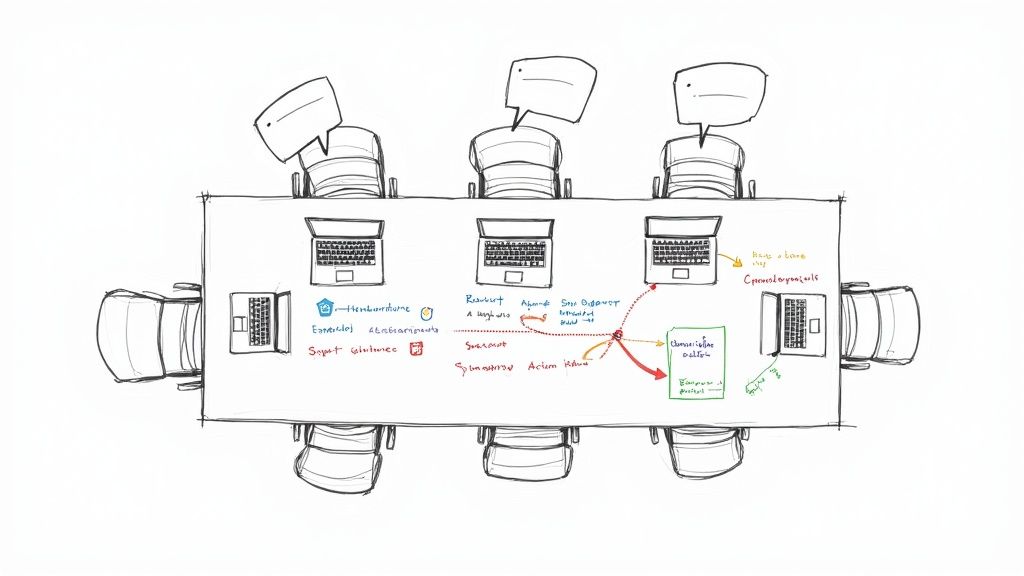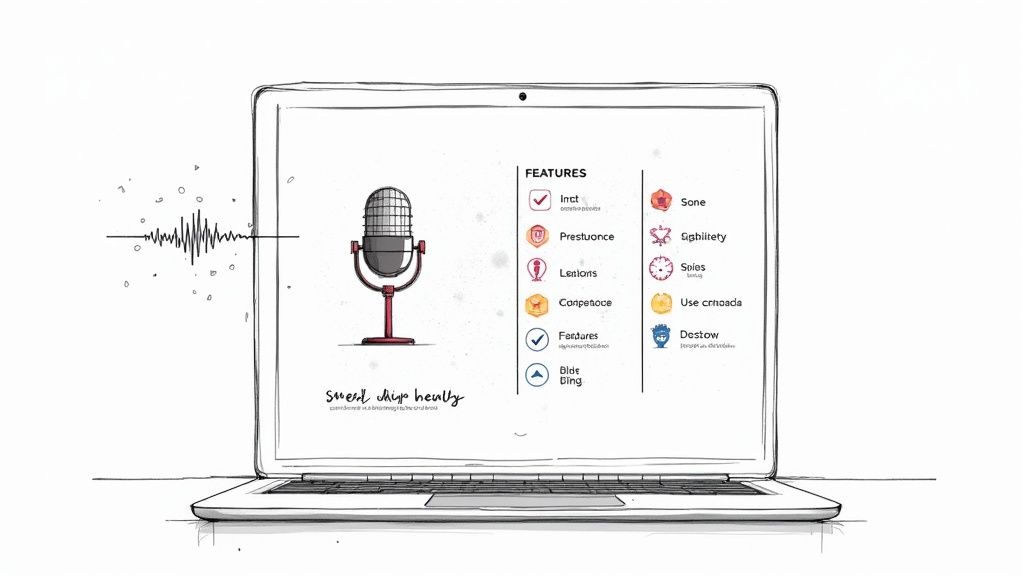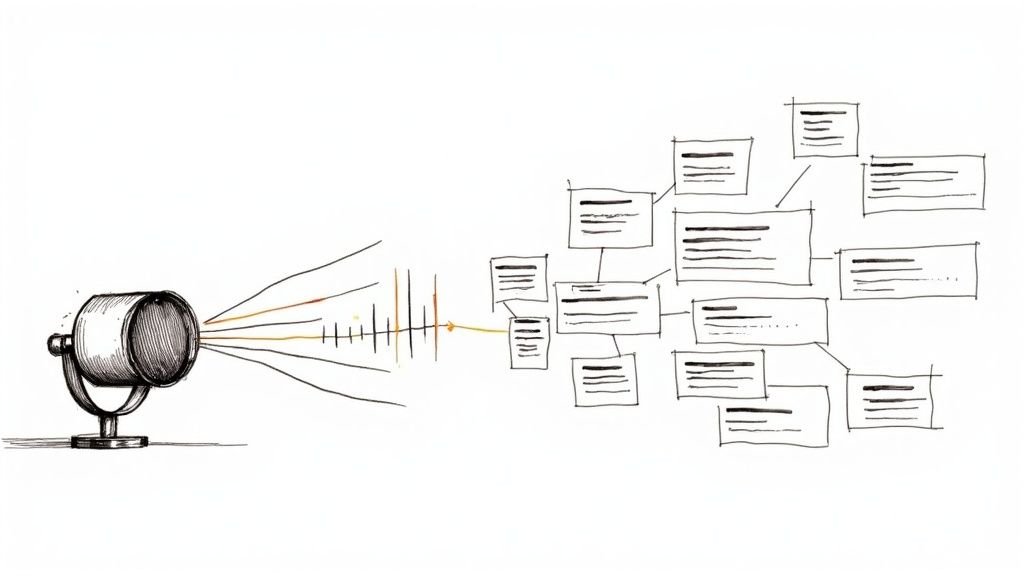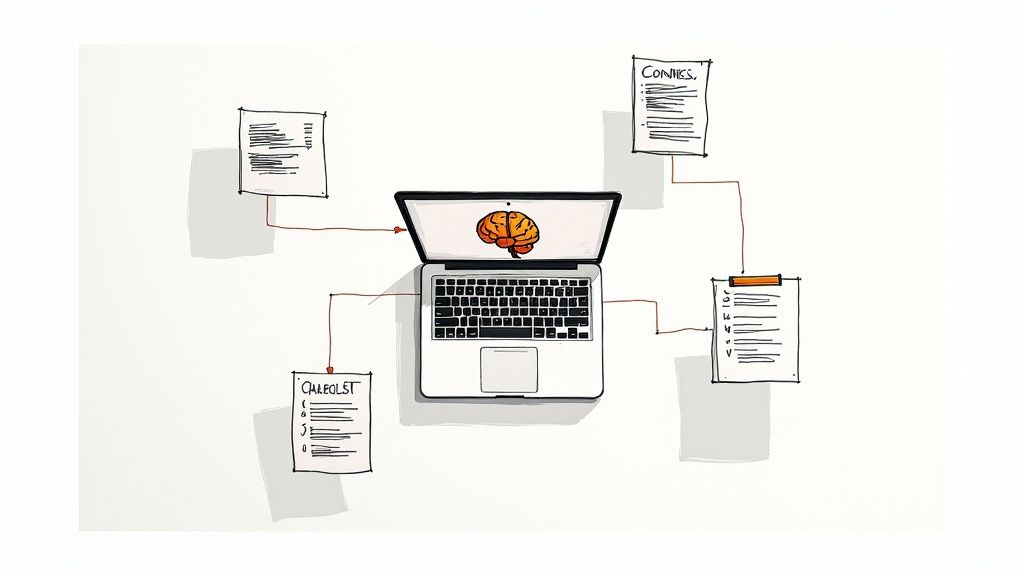8 Actionable Remote Team Management Tips for 2025
The shift to remote work is no longer a trend; it's a fundamental change in how we operate. While many leaders have adapted, the real challenge lies in moving from simply managing a distributed team to actively building a connected, high-performing, and resilient remote-first culture. Standard advice often falls short, repeating the same generic points without offering a clear path to implementation. So, what truly works?
This guide moves past the surface-level recommendations to provide comprehensive, experience-based remote team management tips that deliver tangible results. We've compiled 8 actionable strategies that address the core challenges of leading from a distance, from preventing burnout to fostering genuine connection. This isn't just about surviving remote work; it's about leveraging its unique advantages to create a more effective, engaged, and balanced team.
Each strategy is packed with practical steps, real-world examples, and specific tools you can use to implement them today. You will learn how to establish robust communication protocols, build trust through results-oriented leadership, and create a supportive environment where every team member can thrive. This article is your blueprint for turning common remote work hurdles into your organization's greatest strengths.
1. Establish Clear Communication Protocols
One of the most foundational remote team management tips is to move beyond assuming how your team communicates and instead, intentionally design it. Establishing clear communication protocols means creating a structured, documented framework that dictates which tools to use for specific purposes, sets expectations for response times, and defines the overall flow of information. This proactive approach prevents the common pitfalls of remote work: communication silos, information overload, and the constant "ping" of notifications that leads to burnout.
Without a defined system, team members are left to guess. Should a quick question be a direct message, a public channel post, or an email? The resulting chaos drains productivity and creates anxiety. By creating a clear guide, you empower your team with the clarity needed to communicate effectively and asynchronously across different time zones.
Why This Protocol is Crucial
Remote work pioneers like GitLab and Automattic built their success on meticulously documented communication norms. GitLab’s "handbook-first" approach ensures that processes are transparent and accessible to everyone, minimizing repetitive questions. Similarly, Automattic champions asynchronous communication, using internal blogs (P2s) for deep, thoughtful discussions, which avoids the pressure of immediate responses. These examples prove that a well-defined communication strategy is not just a nice-to-have; it's the operational backbone of a high-functioning remote team.
How to Implement Clear Communication Protocols
Creating your own communication charter doesn't have to be complicated. Start by defining the purpose of each tool in your stack and document it in a central, easily accessible location.
- Urgent Matters: Use a phone call or a specific Slack channel with
@herenotifications. - General Questions: Post in a relevant public Slack channel to promote shared knowledge.
- Project Updates: Share in your project management tool (e.g., Asana, Trello).
- Formal Announcements: Send via a company-wide email or a dedicated announcements channel.
2. Implement Regular Video Check-ins and One-on-Ones
In a remote setting, the spontaneous "water cooler" conversations and casual desk-side chats that build rapport simply don't exist. This makes intentionally scheduled face-to-face interaction one of the most vital remote team management tips. Implementing regular video check-ins, especially one-on-ones, creates dedicated space for the human connection that fosters trust, psychological safety, and open dialogue. These meetings go beyond simple status updates; they are opportunities to understand team members' well-being, discuss career growth, and proactively address challenges before they escalate.
Without these structured touchpoints, managers risk becoming disconnected from their team's reality, leading to disengagement and isolation. By prioritizing consistent video interactions, you replicate the personal connection of an in-office environment, ensuring every team member feels seen, heard, and valued as an individual, not just as a name in a chat window.
Why This Protocol is Crucial
Thought leaders like Kim Scott, author of Radical Candor, and Ben Horowitz have long championed the power of structured one-on-ones. They argue these meetings are the manager's single most important tool for building relationships and driving performance. Companies like Zapier have built their remote-first culture around this principle, conducting weekly one-on-ones to maintain strong manager-employee connections. Similarly, HubSpot uses "manager effectiveness surveys" to ensure these check-ins are genuinely valuable, reinforcing their role as a cornerstone of supportive leadership rather than a bureaucratic chore.
How to Implement Effective Video Check-ins
Making your video meetings count requires structure and intention. The goal is to create a predictable, safe, and productive forum for genuine conversation.
- Use a Shared Agenda: Create a collaborative document for each one-on-one where both manager and team member can add topics beforehand. This ensures the meeting is driven by what's most important to the employee.
- Start with a Personal Check-in: Begin every meeting by asking, "How are you doing?" before diving into work. This simple act builds rapport and shows you care about their well-being.
- Keep Team Meetings Concise: Aim for team meetings to be under 45 minutes to combat video fatigue and maintain high engagement.
- Record Important Sessions: Use an AI meeting notes taker to capture key decisions and action items. This ensures those in different time zones or who couldn't attend can stay informed without having to watch a full recording.
- Alternate Meeting Times: If your team spans multiple time zones, rotate meeting schedules to fairly distribute the inconvenience.
- Ensure Balanced Participation: For team calls, use a turn-taking method or direct questions to quieter members to ensure all voices are heard.
3. Create Comprehensive Documentation Systems
One of the most transformative remote team management tips is to build and maintain a "single source of truth." This involves creating a centralized, comprehensive documentation system where all important processes, decisions, and institutional knowledge are recorded and easily accessible. A robust knowledge base empowers team members to find answers independently, which is critical for asynchronous work across different time zones.
When documentation is an afterthought, teams become reliant on specific individuals, creating knowledge silos and bottlenecks. Repetitive questions flood communication channels, and valuable context is lost when employees leave. By committing to documentation, you create a scalable, resilient operational model that preserves organizational knowledge and boosts autonomy.
Why This Protocol is Crucial
World-class remote companies run on documentation. GitLab’s public handbook, with over 2,000 pages, is a masterclass in transparency, covering everything from engineering workflows to company values. Similarly, Stripe and Amazon have built powerful cultures around written communication, with Amazon famously using detailed six-page memos to drive decision-making. These examples show that documentation isn't just about recording what you do; it's about defining how you operate and scale effectively.
How to Implement Comprehensive Documentation Systems
Building a documentation culture requires intentional habits and clear processes. Start by choosing a central tool like Notion, Confluence, or a simple shared drive, and then integrate documentation into your daily workflows.
- Adopt a 'Documentation-First' Mindset: Make it a rule that decisions and processes are not considered final until they are documented. This simple habit shifts documentation from a chore to a core part of completing work.
- Assign Ownership and Schedule Audits: Prevent content from becoming outdated by assigning ownership for specific sections of your knowledge base. Schedule quarterly or bi-annual audits to remove irrelevant information and update processes.
- Use Templates for Standardization: Create templates for common document types like project briefs, meeting notes, and process guides. Consistency makes information easier to find, read, and update. If your team struggles with this, explore how to improve note-taking skills to build a solid foundation.
- Reward Contributions: Publicly recognize team members who contribute high-quality, helpful documentation. This reinforces its value and encourages others to participate.
4. Set Clear Goals and Measurable Outcomes
One of the most critical remote team management tips is shifting from managing by presence to managing by results. Setting clear goals and measurable outcomes means establishing specific, transparent objectives, often using frameworks like Objectives and Key Results (OKRs), that allow team members to work autonomously while remaining aligned with broader company priorities. This outcome-oriented approach focuses on what is achieved rather than how many hours are worked, which is the cornerstone of building trust and accountability in a remote setting.
When employees know exactly what they are responsible for delivering, they are empowered to structure their own time and problem-solve independently. Without this clarity, remote teams can drift, focusing on tasks that feel urgent but aren't important, leading to wasted effort and disengagement. Clear goals provide the direction needed for everyone to pull in the same direction, even when physically apart.
Why This Protocol is Crucial
The success of goal-setting frameworks is well-documented by industry giants. Originally developed at Intel by Andy Grove and later popularized by John Doerr at Google, OKRs have become a staple for high-performing distributed companies. LinkedIn publicly shares its OKRs to ensure alignment across all departments, while Asana uses its own platform to track company-wide goals with complete transparency. These examples demonstrate that making goals visible and measurable isn't just a management trend; it's a foundational practice for scaling remote operations effectively.
How to Implement Clear Goals and Measurable Outcomes
Implementing a goal-oriented culture requires discipline and a commitment to transparency. The focus should be on collaborative goal-setting and consistent progress tracking, not top-down directives.
- Objective: Define a high-level, aspirational goal (e.g., "Improve Customer Onboarding Experience").
- Key Results: Create 3-5 specific, measurable outcomes that define success (e.g., "Reduce average onboarding time by 20%," "Increase user activation rate to 85%").
5. Foster Trust Through Results-Based Management
One of the most transformative remote team management tips is to shift from monitoring activity to measuring outcomes. Fostering trust through results-based management means evaluating team members on the quality and completion of their work, not the hours they spend online. This approach empowers employees to manage their own schedules and work methods, trusting them to deliver results without the need for micromanagement or intrusive surveillance.
In a remote setting, judging performance by "visible activity" is not just ineffective; it's counterproductive. A results-based framework acknowledges that productivity isn't linear and looks different for everyone. By focusing on outputs, you give your team the autonomy to work when they are most effective, which boosts both morale and performance while building a culture of mutual respect and accountability.
Why This Approach is Crucial
Leaders in remote work have long championed this philosophy. Netflix's renowned "freedom and responsibility" culture, popularized by Reed Hastings, trusts employees to perform at a high level without being constrained by rigid policies. Similarly, Basecamp founders Jason Fried and David Heinemeier Hansson built their company on a foundation of trust, advocating for a 40-hour work week and focusing solely on the work produced. These examples demonstrate that granting autonomy doesn't lead to chaos; it creates a high-trust, high-performance environment where people are motivated to do their best work.
How to Implement Results-Based Management
Transitioning to this model requires clear expectations and a supportive framework. The goal is to create clarity around what needs to be achieved, then step back and let your team determine how to get there.
- Define 'Done' Clearly: For every project and task, establish specific, measurable, and agreed-upon completion criteria.
- Focus Check-ins on Progress: Shift regular check-ins from "What are you doing?" to "What progress have you made, and what roadblocks can I help remove?"
- Avoid Surveillance Software: Build trust by refusing to use tools that track keystrokes or screen activity. Focus on the work, not the clicks.
- Promote Asynchronous Updates: Use project management tools for progress documentation. This practice is supported by effective documentation, and you can see how to perfect your documentation with a solid meeting follow-up template.
- Train Your Managers: Equip managers with the skills to lead based on outcomes, providing guidance on setting clear goals and giving constructive, results-oriented feedback.
6. Invest in the Right Technology Stack
One of the most critical remote team management tips is to strategically invest in a technology stack that empowers, not hinders, your team. This means curating an integrated suite of digital tools designed for seamless collaboration, project management, and communication. The right tech stack removes friction from daily workflows, provides clear visibility into progress, and ensures every team member can contribute effectively, regardless of their location or time zone.
Without a thoughtful selection process, teams often end up with a fragmented collection of redundant, disconnected apps. This "tool sprawl" creates information silos, complicates onboarding, and drains productivity. A well-designed stack, on the other hand, acts as a digital headquarters, providing a central, unified environment for work to happen efficiently.
Why This Investment is Crucial
Successful remote-first companies like Zapier, InVision, and Doist demonstrate that the right technology is the bedrock of their operations. Zapier famously uses its own automation platform to connect over a dozen other tools, creating a seamless flow of information. Similarly, InVision scaled to over 700 remote employees by building its culture around core platforms like Slack, Zoom, and its own design collaboration suite. These companies prove that a deliberate investment in a cohesive toolset is essential for scaling a distributed workforce.
How to Implement the Right Technology Stack
Building a powerful tech stack involves more than just buying software; it requires a strategic approach to selection, integration, and training. Start by auditing your current tools and involving your team in the decision-making process.
- Audit and Consolidate: Regularly review your existing tools to identify and eliminate redundancies.
- Establish a 'Single Source of Truth': Designate one primary tool for each core function: one for asynchronous chat (e.g., Slack, Twist), one for video calls (e.g., Zoom), and one for project management (e.g., Trello, Asana).
- Prioritize Integrations: Select tools that connect with each other. Use integrations and automation platforms to create seamless workflows that reduce manual data entry.
- Provide Comprehensive Training: Develop clear documentation and provide thorough onboarding for every tool. This ensures everyone understands best practices and can leverage the software to its full potential.
7. Prioritize Team Culture and Social Connection
In a physical office, culture develops organically through shared lunches, hallway conversations, and after-work gatherings. For remote teams, one of the most vital remote team management tips is to intentionally engineer these moments of connection. Prioritizing team culture means deliberately creating opportunities for the informal interactions and relationship-building that combat isolation, boost morale, and foster a genuine sense of belonging. This proactive effort transforms a group of isolated individuals into a cohesive and collaborative unit.
Without deliberate action, remote employees can feel like disconnected freelancers, leading to disengagement and higher turnover. By investing in social connection, you build the trust and psychological safety necessary for open communication, creative problem-solving, and long-term loyalty. It’s about ensuring team members feel seen and valued as people, not just as producers of work.
Why This Protocol is Crucial
Companies renowned for their remote-first success, like Zapier and Automattic, place a massive emphasis on culture. Zapier holds bi-annual company-wide retreats in different global locations to foster deep bonds, while Automattic flies its entire team to a single destination for its annual "Grand Meetup." These companies understand that investing in in-person and virtual social events isn't a frivolous expense; it's a strategic investment that strengthens the fabric of the organization, improves cross-functional collaboration, and makes the work more meaningful.
How to Implement a Strong Remote Culture
Building a vibrant remote culture requires a multi-faceted approach that blends virtual activities with a dedicated budget and clear intention. Start by creating dedicated spaces and rituals for non-work interaction.
- Dedicated Channels: Launch non-work Slack or Teams channels for shared interests like
#pets,#book-club, or#gaming. - Automated Pairings: Use tools like Donut to randomly pair team members for informal virtual coffee chats, breaking down departmental silos.
8. Establish Boundaries and Prevent Burnout
One of the most critical remote team management tips is to actively establish and enforce boundaries to prevent employee burnout. Remote work's inherent flexibility can easily blur the lines between professional and personal life, creating an "always-on" culture where team members feel pressured to be constantly available. Establishing clear boundaries means implementing policies, practices, and cultural norms that protect employee well-being by encouraging them to fully disconnect and recharge.
Without intentional guardrails, the home office becomes an office that never closes. This persistent state of work readiness leads to mental exhaustion, decreased productivity, and higher turnover. By proactively building a culture that champions work-life balance, leaders can ensure their teams remain engaged, healthy, and high-performing in the long run.
Why This Protocol is Crucial
Leaders in sustainable work practices, like Basecamp and Arianna Huffington, have long advocated for this approach. Basecamp famously offers a four-day, 32-hour work week during the summer to give employees more personal time. Similarly, countries like France have implemented a "right to disconnect" law, legally protecting employees from after-hours emails. These examples show that setting boundaries isn't about working less; it’s about creating a sustainable framework that boosts focus and overall output. Microsoft Japan’s experiment with a four-day work week famously resulted in a 40% productivity increase.
How to Implement Clear Boundaries
Fostering a culture that respects personal time requires more than just words; it demands concrete actions and policies that leadership models and upholds.
- Define Clear 'Off' Hours: Establish core collaboration hours and empower your team to be unavailable outside of them. Encourage the use of scheduling features in tools like Slack and Gmail to delay message delivery until the next business day.
- Encourage PTO and Disconnection: Actively monitor vacation usage and encourage team members who haven't taken time off to do so. Normalize setting out-of-office messages that clearly state they will not be checking emails.
- Lead by Example: Managers should openly communicate when they are signing off for the day and avoid sending non-urgent requests after hours. This signals to the entire team that disconnecting is not just allowed, but expected.
- Provide Wellness Resources: Offer stipends for mental health support, ergonomic home office setups, or wellness apps. Making resources like therapy easily and confidentially accessible can be a vital support system.
Remote Team Management Tips Comparison
Your Blueprint for Remote Management Success
Navigating the landscape of remote work requires more than just replicating office-based practices online. It demands a deliberate, thoughtful approach to leadership. The strategies detailed in this guide, from establishing crystal-clear communication protocols to investing in a robust technology stack, are not just isolated suggestions. They are interconnected pillars that form a comprehensive blueprint for building a high-performing, engaged, and resilient distributed team. Effective remote team management is a skill built on a foundation of trust, clarity, and intentional connection.
The journey from managing a co-located team to leading a remote one involves a fundamental mindset shift. Instead of managing by presence, you must learn to manage by results. This means moving away from tracking hours and focusing instead on the clear goals and measurable outcomes you’ve set. It involves fostering trust by giving your team the autonomy to perform their work and providing the support they need to succeed, rather than micromanaging their every move. The tips provided, such as creating comprehensive documentation and establishing results-based management, directly support this crucial transition.
From Theory to Action: Your Next Steps
Reading about these remote team management tips is the first step; implementation is where the transformation happens. To avoid feeling overwhelmed, don't try to change everything at once. Instead, adopt an iterative approach.
- Select Your Starting Point: Choose one or two strategies from this article that address your team's most pressing pain point. Is communication feeling chaotic? Start with establishing clear protocols. Are team members feeling disconnected? Prioritize initiatives that foster social connection.
- Communicate the Change: Explain the "why" behind the new process to your team. Frame it as an experiment designed to improve everyone's work experience. For example, you might say, "To ensure our meetings are more focused, we're going to start using a shared agenda and assigning clear action items at the end of each call."
- Gather Feedback and Iterate: After a week or two, solicit feedback. What's working? What isn't? Use this input to refine your approach. This collaborative process not only improves the outcome but also strengthens team buy-in and trust.
The Lasting Impact of Exceptional Remote Leadership
Mastering these skills is not just about boosting quarterly productivity; it's about building a sustainable and healthy work environment where people feel valued and empowered. When you prioritize preventing burnout, champion asynchronous work, and actively build a strong remote culture, you create a team that is not only effective but also loyal and motivated. The future of work is undeniably flexible and distributed. By honing these remote leadership capabilities now, you are not just adapting to a trend; you are positioning yourself and your team for enduring success in the modern professional world. Your commitment to becoming an exceptional remote leader begins with the small, consistent actions you take today.
Ready to enhance your team's communication and accountability? Many of the remote team management tips we covered rely on clear documentation and follow-through. HypeScribe provides instant, highly accurate transcripts and summaries of your virtual meetings, ensuring no action item or key decision gets lost. Try HypeScribe today to turn your team's conversations into actionable progress.





































































